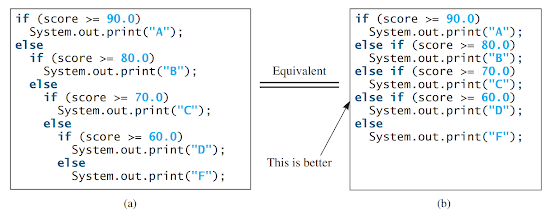Nested if and Multi-Way if-else Statements


History of The Java:
Java was developed by a team led by James Gosling at Sun Microsystems. Sun Microsystems was purchased by Oracle in 2010. Originally called Oak, Java was designed in 1991 for use in embedded chips in consumer electronic appliances. In 1995, renamed Java, it was redesigned for developing Web applications.
Java has become enormously popular. Its rapid rise and wide acceptance can be traced to its design characteristics, particularly its promise that you can write a program once and run it anywhere. As stated by its designer, Java is simple, object oriented, distributed, interpreted, robust, secure, architecture neutral, portable, high performance, multithreaded, and dynamic
The World Wide Web is a global repository of electronic information accessible via the Internet. The Web, which has been in existence for over forty years, owes its popularity to the colorful and user-friendly interface provided by Web browsers.
Java gained early popularity due to its ability to run programs, known as applets, directly from a Web browser. These applets employ graphical elements such as buttons, text fields, and radio buttons to enhance user interaction and process requests, making the Web more dynamic and engaging. Applets are embedded within HTML files, which use a simple scripting language called HTML to structure documents, link them on the Internet, and incorporate multimedia elements like images, sound, and video.
In addition to applets, Java has evolved to enable the development of rich Internet applications (RIAs), which deliver features and functions comparable to traditional desktop applications. Java is widely used for creating applications on Web servers that process data, perform computations, and generate dynamic Web pages. Many commercial websites rely on Java for their backend development.
Java is a versatile programming language that can be utilized to build applications for various platforms, including desktop computers, servers, and small handheld devices. It has become particularly prominent in the development of software for Android cell phones, further highlighting its adaptability and widespread use in the technological landscape.
nice sir. Can you write all main topics of java.
ReplyDeletenice way you explains java history.
Delete